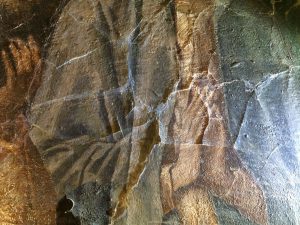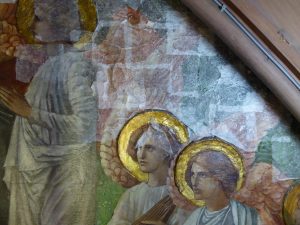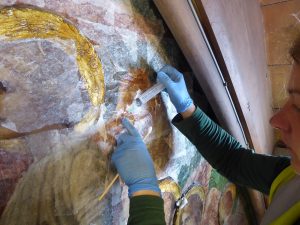All Saints Church was constructed between 1843-1890 in the village of Thelwall, Cheshire to accommodate the growing population. Now Grade II listed we completed conservation and repair of the wall painting above the chancel arch.
The ornate decorative scheme was designed and completed around 1896 by Messrs. Shrigley and Hunt, of Lancaster and London. Damp penetration within the chancel wall was a recurring issue mentioned in the church records from approximately 1930s. Several campaigns of repair and redecoration were undertaken over time, resulting in a complete overpainting of the interior except for the chancel arch painting and two smaller areas. Repointing of the east gable of the nave in lime mortar in the early phase of works was the final step of improvements to the chancel wall.
 The work undertaken by Hirst was informed by earlier condition assessments and technical analysis.
The work undertaken by Hirst was informed by earlier condition assessments and technical analysis.
The chancel arch painting is on plaster applied to the brick wall of the arch. The painting represents Christ seated on the rainbow surrounded by Saints and Angles. All figures have gilded relief halos that were applied directly onto the surface of the painting.
The condition assessment found areas of friable and fracturing plaster. In addition to overpaint and unsuitable reconstructions. The survey of the paintings indicated that the scheme was applied directly to the plaster without a ground layer.
 Work was undertaken in stages to allow complete carbonation of lime plaster repairs before any recreation of painted decoration could safely take place.
Work was undertaken in stages to allow complete carbonation of lime plaster repairs before any recreation of painted decoration could safely take place.
Temporary surface protection was applied to sections of friable plaster and around the areas of unsuitable plaster to be removed, to enable repairs in the form of grouting, fracture filling and re-plastering to be undertaken.
 Nano-lime products and lime-based mortars and grouts with reduced water content were used for the repairs and for setting thick and distorted paint flakes. Smaller paint flakes were consolidated using a thermoplastic adhesive.
Nano-lime products and lime-based mortars and grouts with reduced water content were used for the repairs and for setting thick and distorted paint flakes. Smaller paint flakes were consolidated using a thermoplastic adhesive.
Dirty varnish was removed along with the modern areas of unsightly overpaint using solvents and solvent gels. Watercolours and Paraloid B-72 with dry pigments were used for the retouching of small losses.
Larger areas of reconstruction on carbonated repairs were executed in acrylic paint.
An open evening was held at the church to present the project to the entire parish community.